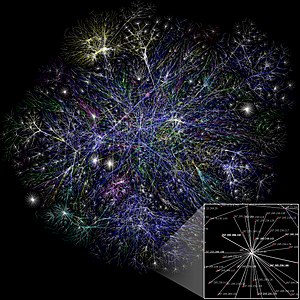
- Image via Wikipedia
Internet networking technology is intended to support anarchic growth
In a dimly lit chamber festooned with wires and hidden in one of California’s largest data centers, Tim Pozar is changing the shape of the Internet.
He is using what Internet engineers refer to as a “meet-me room.” The room itself is enclosed in a building full of computers and routers. What Mr. Pozar does there is to informally wire together the networks of different businesses that want to freely share their Internet traffic.
The practice is known as peering, and it goes back to the earliest days of the Internet, when organizations would directly connect their networks instead of paying yet another company to route data traffic. Originally, the companies that owned the backbone of the Internet shared traffic. In recent years, however, the practice has increased to the point where some researchers who study the way global networks are put together believe that peering is changing the fundamental shape of the Internet, with serious consequences for its stability and security. Others see the vast increase in traffic staying within a structure that has remained essentially the same.
What is clear is that today a significant portion of Internet traffic does not flow through the backbone networks of giant Internet companies like AT&T and Level 3. Instead, it has begun to cascade in torrents of data on the edges of the network, as if a river in flood were carving new channels.
Some of this traffic coursing through new channels passes through public peering points like Mr. Pozar’s. And some flows through so-called dark networks, private channels created to move information more cheaply and efficiently within a business or any kind of organization. For instance, Google has privately built such a network so that video and search data need not pass through so many points to get to customers.
By its very nature, Internet networking technology is intended to support anarchic growth. Unlike earlier communication networks, the Internet is not controlled from the top down. This stems from an innovation at the heart of the Internet — packet switching. From the start, the information moving around the Internet was broken up into so-called packets that could be sent on different paths to one destination where the original message — whether it was e-mail, an image or sound file or instructions to another computer — would be put back together in its original form. This packet-switching technology was conceived in the 1960s in England and the United States. It made delivery of a message through a network possible even if one or many of the nodes of the network failed. Indeed, this resistance to failure or attack was at the very core of the Internet, part of the essential nature of an organic, interconnected communications web with no single control point.
During the 1970s, a method emerged to create a network of networks. The connections depended on a communication protocol, or set of rules, known as TCP/IP, a series of letters familiar to anyone who has tried to set up their own wireless network at home. The global network of networks, the Internet, transformed the world, and continues to grow without central planning, extending itself into every area of life, from Facebook to cyberwar.
Everyone agrees that the shape of the network is changing rapidly, driven by a variety of factors, including content delivery networks that have pushed both data and applications to the edge of the network; the growing popularity of smartphones leading to the emergence of the wireless Internet; and the explosion of streaming video as the Internet’s predominant data type.
Related articles by Zemanta
- What is cloud computing ? (mediacyclone.eu)
- Mobile Data Traffic Expected to Surge (bits.blogs.nytimes.com)









